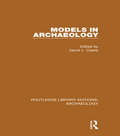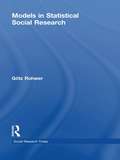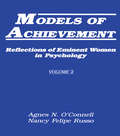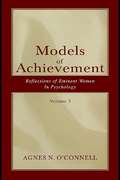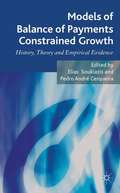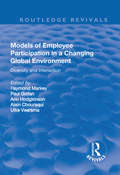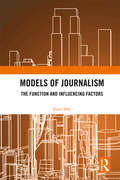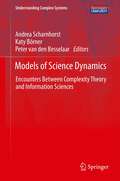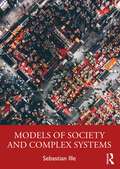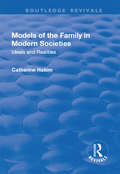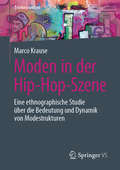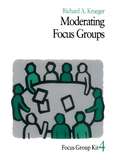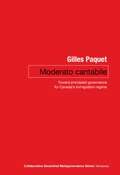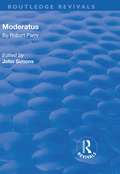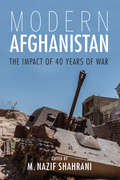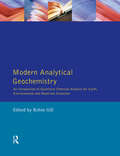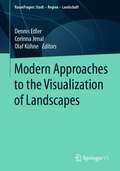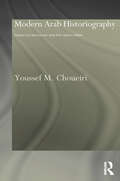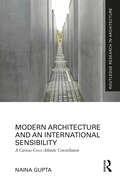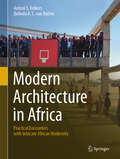- Table View
- List View
Models in Archaeology (Routledge Library Editions: Archaeology)
by David L. ClarkeThis major study reflects the increasing significance of careful model formation and testing in those academic subjects that are struggling from intuitive and aesthetic obscurantism toward a more disciplined and integrated approach to their fields of study. The twenty-six original contributions represent the carefully selected work of progressive archaeologists around the world, covering the use of models on archaeological material of all kinds and from all periods from Palaeolithic to Medieval. Their common theme is archaeological generalisation by means of explicit model building, testing, modification and reapplication. The contributors seek to show that it is the use of certain models in particular ways that defines archaeology as the practice of one discipline, with a set of general tenets that are as applicable in Peru as in Persia, Australia as Alaska, Sweden as Scotland, on material from the second millennium B.C. to the second millennium A.D. They assert that careful model formulation within archaeology and the cautious exchange and testing of models within and beyond the discipline provides the only route to the formation of the common, internationally valid body of theory which defines a vigorous and coherent discipline and distinguishes it from being a collection of merely regionally applicable special cases.
Models in Statistical Social Research (Social Research Today)
by G¨otz RohwerModels in Statistical Social Research provides a comprehensive insight of models used in statistical social research based on statistical data and methods. While traditionally understood statistical models relate to data generating processes which presuppose facts, this book focuses on analytical models which relate to substantial processes generating social facts. It formally develops individual-level, population-level, and multilevel versions of such models and uses these models as frameworks for the definition of notions of functional causality. The book further develops a distinction between the representation of states and events, which is then used to formally distinguish between comparative and dynamic notions of causality. It is shown that, due to the involvement of human actors in substantial processes considered in social research, the conceptual framework of randomized experiments is of only limited use. Instead, modelling selection processes should become an explicit task of social research.
Models of Achievement: Reflections of Eminent Women in Psychology, Volume 2
by Agnes N. O'Connell Nancy Felipe RussoProviding role models of excellence for contemporary women and men and contributing to the understanding of the educational and career development of high achieving women, these autobiographical essays of seventeen women and their achievements generate a deeper appreciation of the vital role of women in the development of contemporary psychology.
Models of Achievement: Reflections of Eminent Women in Psychology, Volume 3
by Agnes N. O’ConneThis outstanding book contains inspiring stories of late 20th century women who broke new ground in psychological knowledge and its applications. The lives and careers of 53 women are examined within social and historical contexts using three levels of analysis--the individual, the group, and the universal. The thoughtful autobiographies and the perceptive, integrative analyses increase understanding of the personal and professional development of these women, provide insights into their patterns of achievement, and illuminate new ways of thinking about and perceiving women. This extraordinary book is a valuable resource for libraries and researchers, provides knowledge and inspiration for a wide range of readers, and is an excellent supplementary text for courses in the psychology of women, history of psychology, lifespan development, career development, and women's studies.
Models of Balance of Payments Constrained Growth
by Elias Soukiazis Pedro A. CerqueiraThis book extends Thirlwall's model and adapts its implications to the current problems facing developed and emerging economies. In this context, this book combines theoretical models and empirical applications, unveiling new results and highlighting the importance of the balance of payments as a constraint to growth.
Models of Care in Maternity Services
by Sabaratnam Arulkumaran Tahir Mahmood Charnjit Dhillon Philip OwenThis book helps all those working in maternity services to improve the quality of the care they offer. Improvement is driven by clinical effectiveness and increasing patient demands, and for each area of practice described this book outlines the service organisation needed to achieve this improvement. The goal is to help clinicians take responsibility for developing services that meet the needs of their patients as well as managing their individual medical conditions. The book demonstrates that much can be achieved within current resources and without major additional expense. Different approaches are demonstrated, but the key issue is the patient pathway. Trainees, clinicians, managers and commissioners of services will find this book of practical value. There should be a copy on the shelves of every hospital obstetric unit.
Models of Employee Participation in a Changing Global Environment: Diversity and Interaction (Routledge Revivals)
by Paul Gollan Raymond Markey Ann Hodgkinson Alain Chouraqui Ulke VeersmaThis title was first published in 2001. Management of the employment relationship changed markedly in the last two decades of the 21st century, and a major part of this has been the extension of employee involvement and participation in the workplace. Modern management theorists and researchers have commonly emphasized the importance of two-way communication and co-operation between management and labour in determining the success of human resource management (HRM) strategy and in maximizing workplace efficiency. Some researchers argue employee participation and empowerment are progressive management practices which have universal benefits to performance enhancement, as opposed to most other HRM practices whose success is contingent upon the organizational context. This title explores these themes through an international collection of case studies, which are the outcome of a comparative project of the Workers' Participation Study Group of the International Industrial Relations Association (IIRA).
Models of Journalism: The functions and influencing factors
by Peter BroModels of Journalism investigates the most fundamental questions of how journalists can best serve the public and what factors enable or obstruct them in doing so. The book evaluates previous scholarly attempts at modeling the function and influencing factors of journalism, and proceeds to develop a range of important new models that take contemporary challenges faced by journalists and journalism into account. Among these new models is the "chronology-of-journalism", which introduces a new set of influencing factors that can affect journalists in the 21st century. These include internal factors – journalistic principles, precedents and practices – and external factors – journalistic production, publication and perception. Another new model, the "journalistic compass", delineates differences and similarities between some of the most important journalistic roles in the media landscape. For each new model, Peter Bro takes the actions and attitudes of individual journalists as its starting point. Models of Journalism combines practice and theory to outline and assess existing theoretical models alongside original ones. The book will be a useful tool for researchers, lecturers and practitioners who are engaged with the ever-evolving notions of what journalism is and who journalists are.
Models of Science Dynamics
by Peter Van Besselaar Andrea Scharnhorst Katy BörnerModels of Science Dynamics aims to capture the structure and evolution of science, the emerging arena in which scholars, science and the communication of science become themselves the basic objects of research. In order to capture the essence of phenomena as diverse as the structure of co-authorship networks or the evolution of citation diffusion patterns, such models can be represented by conceptual models based on historical and ethnographic observations, mathematical descriptions of measurable phenomena, or computational algorithms. Despite its evident importance, the mathematical modeling of science still lacks a unifying framework and a comprehensive study of the topic. This volume fills this gap, reviewing and describing major threads in the mathematical modeling of science dynamics for a wider academic and professional audience. The model classes presented cover stochastic and statistical models, system-dynamics approaches, agent-based simulations, population-dynamics models, and complex-network models. The book comprises an introduction and a foundational chapter that defines and operationalizes terminology used in the study of science, as well as a review chapter that discusses the history of mathematical approaches to modeling science from an algorithmic-historiography perspective. It concludes with a survey of remaining challenges for future science models and their relevance for science and science policy.
Models of Society and Complex Systems
by Sebastian IlleModels of Society and Complex Systems introduces readers to a variety of different mathematical tools used for modelling human behaviour and interactions, and the complex social dynamics that drive institutions, conflict, and coordination. What laws govern human affairs? How can we make sense of the complexity of societies and how do individual actions, characteristics, and beliefs interact? Social systems follow regularities which allow us to answer these questions using different mathematical approaches. This book emphasises both theory and application. It systematically introduces mathematical approaches, such as evolutionary and spatial game theory, social network analysis, agent-based modelling, and chaos theory. It provides readers with the necessary theoretical background of each toolset as well as the underlying intuition, while each chapter includes exercises and applications to real-world phenomena. By looking behind the surface of various social occurrences, the reader uncovers the reasons why social systems exhibit both cultural universals and at the same time a diversity of practices and norms to a degree that even surpasses biological variety, or why some riots turn into revolutions while others do not even make it into the news. This book is written for any scholar in the social sciences interested in studying and understanding human behaviour, social dynamics, and the complex systems of society. It does not expect readers to have a particular background apart from some elementary knowledge and affinity for mathematics.
Models of the Family in Modern Societies: Ideals and Realities
by Catherine HakimThis title was first published in 2003. This text reports on two nationally representative surveys of men and women in Britain and Spain, the former being funded by the Future of Work Research Programme and conducted by the ONS. Catherine Hakim presents a study of ideal models of the family and family roles, work orientation, patriarchal values and lifestyle preferences, showing how these impact on women's marital histories, fertility, employment patterns and occupational segregation, but not on men's labour market participation. Lifestyle preferences and work orientations have a strong impact on women's activities, and especially on married women's choices, but patriarchal values have almost no impact on behaviour. The book also covers educational homogamy, housing classes, labour mobility and contrasts between ethnic minority groups in core values and labour market participation.
Modelwork: The Material Culture of Making and Knowing
by Martin Brückner Sarah Wasserman Sandy IsenstadtHow making models allows us to recall what was and to discover what still might be Whether looking inward to the intricacies of human anatomy or outward to the furthest recesses of the universe, expanding the boundaries of human inquiry depends to a surprisingly large degree on the making of models. In this wide-ranging volume, scholars from diverse fields examine the interrelationships between a model&’s material foundations and the otherwise invisible things it gestures toward, underscoring the pivotal role of models in understanding and shaping the world around us. Whether in the form of reproductions, interpretive processes, or constitutive tools, models may bridge the gap between the tangible and the abstract.By focusing on the material aspects of models, including the digital ones that would seem to displace their analogue forebears, these insightful essays ground modeling as a tactile and emphatically humanistic endeavor. With contributions from scholars in the history of science and technology, visual studies, musicology, literary studies, and material culture, this book demonstrates that models serve as invaluable tools across every field of cultural development, both historically and in the present day.Modelwork is unique in calling attention to modeling&’s duality, a dynamic exchange between imagination and matter. This singular publication shows us how models shape our ability to ascertain the surrounding world and to find new ways to transform it. Contributors: Hilary Bryon, Virginia Tech; Johanna Drucker, UCLA; Seher Erdoğan Ford, Temple U; Peter Galison, Harvard U; Lisa Gitelman, New York U; Reed Gochberg, Harvard U; Catherine Newman Howe, Williams College; Christopher J. Lukasik, Purdue U; Martin Scherzinger, New York U; Juliet S. Sperling, U of Washington; Annabel Jane Wharton, Duke U.
Moden in der Hip-Hop-Szene: Eine ethnographische Studie über die Bedeutung und Dynamik von Modestrukturen (Erlebniswelten)
by Marco KrauseDiese Arbeit widmet sich dem Thema der szenespezifischen Moden. Der Kern dieser Forschungsarbeit besteht daraus, anhand einer ethnographischen Studie das szenespezifische Modephänomen im Kontext der Hip-Hop-Szene in seinen Strukturen abzubilden und dessen Facetten, Bedeutungen und Differenzierungen aufzudecken, um daran anknüpfend aufzuzeigen, welche Produkte beziehungsweise Produkteigenschaften die Szene-Mitglieder als Mode deklarieren und konsumieren und welchen Stellenwert dieses Phänomen innerhalb der Szene einnimmt. Die übergreifende Zielstellung bildet dabei die Generierung eines differenzierteren Betrachtungsansatzes des Modephänomens, welcher auf die Vergemeinschaftungsform der Hip-Hop-Szene bezogen ist und deren innere Strukturen und Facetten berücksichtigt.Der InhaltForschungsstand: Moden und Szenen • Forschungsstand: Hip-Hop-Szene • Forschungsdesign • Konsumrelevante Werte, Strukturen und Relationen in der Hip-Hop-Szene • Produktkonsum in der Hip-Hop-Szene • Moden in der Hip-Hop-SzeneDer AutorMarco Krause ist Soziologe mit Fokus auf den Bereich Konsumsoziologie und Consultant im Bereich Digital Intelligence.
Moderating Focus Groups
by Professor Richard A. KruegerThis volume is indispensable for those who want to improve their focus group moderating skills. Based on years of experience in moderating and training others to moderate, Richard Krueger offers tips and sound advice on how to gain expertise in leading focus groups. The book is an easy-to-read overview of critical skills needed by moderators, the various approaches that successful moderators use and strategies for handling difficult situations. Beginners will find an invaluable guide and the more experienced will discover tips and strategies for honing their skills.
Moderating Focus Groups: A Practical Guide for Group Facilitation
by Dr Thomas L. GreenbaumDesigned specifically for the needs of the focus group moderator, this comprehensive guide covers everything from pre-session participant recruitment to post-session reporting. In addition, the author includes a wealth of advanced and new techniques, such as those for managing group dynamics, energizing a tired group, projective techniques, personality association and position fixing. Extremely practical and well-written, the book includes chapter summaries and a helpful glossary.
Moderato Cantabile: Toward Principled Governance for Canada’s Immigration Policy
by Gilles PaquetToward principled governance for Canada’s immigration regime Canada has engaged in an immigration policy experiment of momentous importance over the last 25 years: it has almost doubled the flow of new immigrants. This has not only strained Canada s absorptive capacity and the common public culture, and increased the costs of immigration for Canadians, but it has also led the more recent cohorts of immigrants to experience much greater difficulty integrating into their new homeland, causing them to fall more and more below the level of income of the Canadian-born. Canadians have been disinformed by officials, the intelligentsia, and the media about the real impact of mass immigration on the economy and about its potential capacity to counter the effect of the aging of Canadian population. Canadians have been hoodwinked into accepting that maximum diversity is optimum diversity.
Moderatus
by John SimonsThis title was first published in 2002. "Moderatus" was an Elizabethan romance, probably the first published work of the 16th-century Welsh gentleman Robert Parry; it was produced in 1595 by the bookseller, publisher, and printer Richard Jones. In this volume John Simons offers in modern typography an edition of this now-scarce text, with explanatory notes and an extensive introduction that places the work in its historical context. He also presents what biographical information is known about the author of "Moderatus" and what is known of the book's publication history, and discusses such pertinent issues as the travel experience of Elizabethans, their knowledge of other languages than English, and their experience of translating and translations. Simons demonstrates how works like "Moderatus" do impel us to look more carefully at the inter-relationships of writers and readers and teach us a good deal about the habits of mind which those readers brought to more familiar texts.
Modern Afghanistan: The Impact of 40 Years of War
by M. Nazif ShahraniWhat impact does 40 years of war, violence, and military intervention have on a country and its people? Modern Afghanistan is a collection of the work of interdisciplinary scholars, aid workers, and citizens to assess the impact of this prolonged conflict on Afghanistan. Nearly all of the people in Afghan society have been affected by persistent violent conflict. Issues considered in this volume include social and political dynamics, issues of gender, and the shifting relationships between tribal, sectarian, and regional communities. Contributors consider topics ranging from masculinity among the Afghan Pashtun to services offered for the disabled, and from Taliban extremism to the role of TV in the Afghan culture wars. Prioritizing the perspective and experiences of the people of Afghanistan, the contributors offer new insights into the lives of those who are hoping to build a secure future on the rubble of a violent past.
Modern Analytical Geochemistry: An Introduction to Quantitative Chemical Analysis Techniques for Earth, Environmental and Materials Scientists (Longman Geochemistry Series)
by Robin GillA comprehensive handbook of analytical techniques in geochemistry which provides the student and the professional with an understanding of the wide spectrum of different analytical methods that can be applied to Earth and environmental materials, together with a critical appreciation of their relative merits and limitations.
Modern Animalism
by Glenn WillmottFrom T. S. Eliot's Sweeney to C. S. Lewis's Aslan, modern writing has been filled with strange new hybrid human-animal creatures. Feeding on consumer society, these 'modern primitive' figures often challenge mainstream ideals by discovering wealth in habitats and resources rather than in economic exchange. What compels our post-human identification with these characters?Modern Animalism explores representations of the human-animal 'problem creature' in a broad assortment of literature and comics from the late nineteenth century to the present -- including authors such as Woolf, Joyce, Lawrence, Moore, Murakami, Pullman, Coetzee, and Atwood, and comics creators such as McCay, Herriman, Miyazaki, and Morrison. Drawing on a wide range of scholarship, from environmental economics to psychology, Glenn Willmott examines modern and post-modern allegories of the environment, the animal, and economics, highlighting the enduring and seductive appeal of the modern primitive in an age when living with less remains a powerful cultural wish.
Modern Approaches to the Visualization of Landscapes (RaumFragen: Stadt – Region – Landschaft)
by Olaf Kühne Corinna Jenal Dennis EdlerThe volume deals with the effects of digitization on spatial and especially landscape construction processes and their visualization. A focus lies on the generation mechanisms of 'landscapes' with digital tools of cartography and geomatics, including possibilities to model and visualize non-visual stimuli, but also spatial-temporal changes of physical space. Another focus is on how virtual spaces have already become part of the social and individual construction of landscape. Potentials of combining modern media of spatial visualization and (constructivist) landscape research are discussed.
Modern Arab Historiography: Historical Discourse and the Nation-State (Culture and Civilization in the Middle East #1)
by Youssef ChoueiriInclusing a new introduction and conclusion, this revised second edition deals with a vital yet neglected ingredient in modern Arab culture. It is the only scholarly study of Arab historiography. It covers the periods 1820-1920 (Pioneers and Amateurs) and 1920 to today (Professional Historians: Managers of Legitimation). This work is a major contribution not only to the study of Arab historiography but to our understanding of modern Arab thought.
Modern Architecture and an International Sensibility: A Curious Cross-Atlantic Constellation (Routledge Research in Architecture)
by Naina GuptaModern Architecture and an International Sensibility: A Curious Cross-Atlantic Constellation presents an alternative history of internationalism and modernism, with a focus on the role of architecture and spatial practices. Beginning at the tail-end of the peace movements— the turn of the twentieth century— and ending with the Nuremberg trials, the book highlights the part played by individual agency, social reform and architecture in moulding a working everyday definition of what it meant to be international during this time. By viewing internationalism through the lens of the individual and the body, both as initiator and subject, it is repositioned as an integral part of everyday life, rather than simply understood to be concerned with geopolitical relations between nations and their institutions.The book furthers a research methodology that is multidisciplinary and transnational. It will therefore be of interest to researchers and students of architecture and international history.
Modern Architecture in Africa: Practical Encounters with Intricate African Modernity
by Antoni S. Folkers Belinda A. van BuitenThis book offers unique insights into modern African architecture, influenced by modern European architecture, and at the same time a natural successor to existing site-specific and traditional architecture. It brings together the worlds of traditional site-specific architecture with the Modernist Project in Africa, which to date have only been considered in isolation.The book covers the four architectural disciplines: urban planning, building technology, building physics, and conservation. It includes an introduction with a historical outline and an analysis and comparison of a number of projects in various countries in Africa. On the basis of examples drawn from practice, the author documents and describes the hybrid architectural forms that have emerged from the confrontation and fusion with (pre)modern Western architecture and urban planning, and in so doing he also narrates the history of African architecture.
Modern Armenia: People, Nation, State
by Gerard LibaridianModern Armenia reviews Armenian politics and political thinking from the mid-nineteenth century to the present, and the evolution of Armenians from peoplehood to statehood. Written by a key governmental advisor in the early years of Armenian independence, this book analyzes the internal dynamics of the revolutionary movement, the genocide, the Armenian Diaspora, its recovered statehood and recent independence, as well as the relationship of these developments to processes in the Ottoman/Turkish, Russian, and Western states. It also explores current dilemmas and future choices independent Armenia faces today.Libaridian concludes with an overview of Armenia and Armenians during the past two decades, including the rebirth of independent Armenia, its foreign and security policy options, its position within the region, and its relations with the Diaspora. Fascinating and timely, Modern Armenia will be of interest to students and scholars of Armenian history, independence movements, the dissolution of the Soviet empire, foreign relations, and political science.
